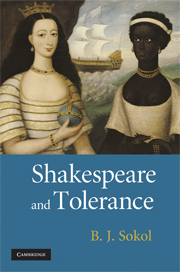Book contents
- Frontmatter
- Contents
- List of abbreviated titles
- Introduction
- 1 Shakespeare, jokes, humour, and tolerance
- 2 Shakespeare, gender, and tolerance
- 3 Shakespeare, tolerance, and nationality
- 4 Shakespeare, tolerance, and religion
- 5 ‘Race’, part one
- 6 ‘Race’, part two: Shakespeare and slavery
- 7 Afterword: tolerance as a species of love
- Notes
- Bibliography
- Index
6 - ‘Race’, part two: Shakespeare and slavery
Published online by Cambridge University Press: 20 August 2009
- Frontmatter
- Contents
- List of abbreviated titles
- Introduction
- 1 Shakespeare, jokes, humour, and tolerance
- 2 Shakespeare, gender, and tolerance
- 3 Shakespeare, tolerance, and nationality
- 4 Shakespeare, tolerance, and religion
- 5 ‘Race’, part one
- 6 ‘Race’, part two: Shakespeare and slavery
- 7 Afterword: tolerance as a species of love
- Notes
- Bibliography
- Index
Summary
TYPES OF SLAVERY KNOWN TO ELIZABETHANS
In a particularly careful study of the tragedy of Atlantic plantation slavery, Jonathan Schorsch dates the European emergence of notions corresponding with Racialism, finding that although most historians claim a later origin, some have dated this emergence to the second half of the seventeenth century (which is, of course, still well after Shakespeare's lifetime). Starting from that point, Schorsch detects a process that he finds still continuing:
The hammering out of the precise meaning of the term negro or Black or mulatto, and the system of governing subjects assigned to each category, occurred over the course of two or three centuries – in fact have never ended.
If, as he says, such a process is still in progress, we are in the early twenty-first century living out the waning legacy of the massive, mainly eighteenth-century Atlantic slave trade (a fine example of a ‘political or economic interest’), and so inhabit a highly racially sensitised culture. Was Shakespeare's culture similarly sensitised? To help answer that question we need to ask what views were taken in his England of slavery, and in particular what significances the word ‘slave’ had in Shakespeare's culture and in his plays.
Elizabethans were aware of three kinds of slavery: the enslavement of Africans or Native Americans employed by Spanish and Portuguese colonists in the New World; the enslavement of captives in war – in galleys or otherwise – who were not able to provide ransom payments; and the enslavement of those taken by corsair raiders on land or sea.
- Type
- Chapter
- Information
- Shakespeare and Tolerance , pp. 142 - 168Publisher: Cambridge University PressPrint publication year: 2008

